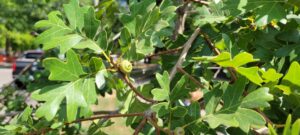Category: Street trees
Trees are part of the solution to climate chaos
A letter from executive director Yashar Vasef, with an update about community tree planting in Portland
Friends,
It’s official: We need trees more than ever. Heatwaves, flooding, and all of the increasingly catastrophic effects of climate change make it clear that every day needs to be the day for climate action. Friends of Trees has been planting trees in neighborhoods and natural areas for 32 years; we’re planting street and yard trees that will shade our streets and cool our homes, prioritizing low-canopy, underserved neighborhoods, and we’re also planting native trees and shrubs to help restore sensitive natural areas.
Since 1989 we’ve planted more than 870,000 trees and native shrubs, and we’ve done this through engaging tens of thousands of community members, and while implementing and growing programming that aims to do this work inclusively and equitably.
“At a time when climate change is making heat waves more frequent and more severe, trees are stationary superheroes.” (New York Times, 7/2/2021)
It’s not enough. We are experiencing climate chaos, and trees are increasingly promoted as a major solution, which is why you may have seen Friends of Trees in the news recently. Some of that news focused on our 13 year partnership with the City of Portland Bureau of Environmental Services.
It seemed until recently that funding for our work planting and caring for street and yard trees in Portland was ending, and our concern was that with our funding ending, and without funding being awarded to anyone for community tree planting, this critical work would be suspended for an unknown amount of time. And given climate change’s growing severity, we simply cannot afford to even temporarily pause community tree planting.
It is widely acknowledged that planting trees is a key part of a comprehensive climate strategy. It is our experience at Friends of Trees that planting trees with community members is also key to fighting climate change.
Planting and caring for trees increases community members’ engagement with the environment and overall participation in civic life, including engaging around climate action. There is a ripple effect from volunteering to plant trees that also fights climate change, beyond the actual trees. We expect to have quantitative data supporting this from the research we are conducting through our community grant from the Robert Wood Johnson Foundation, look for an update this winter.
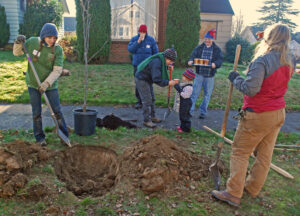
We have since learned that we will receive gap funding to partially continue our Portland tree planting and care efforts through spring 2022, and our deepest thanks go to BES, and also to Commissioner Mingus Mapps’ office, which played a critical role in this positive development. However, there are some significant changes that if implemented would drastically change community tree planting in the City of Portland. As details firm up we will continue to keep you updated.
This particular contract is so important because so much of it has funded planting street trees. Trees play an invaluable role in combating heat islands brought on by climate change, and street trees especially so. Streets and concrete sidewalks absorb and retain heat, and release it at night; street trees help fight this effect and are crucial to cooling neighborhoods.
By now most of us are aware of the inequities with Portland’s tree canopy, one result of which is more heat islands in low-canopy/low-income/under-served neighborhoods. Friends of Trees prioritizes these neighborhoods and will continue to advocate for partnerships and practices that plant trees where they are needed most.
Looking past this upcoming season, BES has said they will issue a new RFP (Request For Proposals) for this sort of work–community tree planting and tree care–sometime this fall/winter, and our understanding is that, while they acknowledge the success of our partnership, they would like to engage other, diverse community partners. And to that we say, Yes!
We fully support BES taking on a new approach to their contracts in a way that prioritizes smaller and BIPOC organizations. It is our belief that uplifting such organizations in this work will make our mission stronger and brings all of us closer to climate justice by introducing voices at the table which were previously shut out. This is why Friends of Trees, during the evolution of our 13 year partnership with BES, has entered into partnerships in this work with organizations such as APANO, Blueprint Foundation, POIC, Verde, Wisdom of the Elders, and others.

Yes, BES (and all other public and private funders) should absolutely fund more community organizations in the fight against climate change and toward climate justice, and we fully support an open RFP process. As more funders work to diversify their support of community organizations, we encourage an approach that increases the funding pie (as in, make a bigger pie as opposed to cutting smaller slices) so more partners can be included. The planet is literally on fire and NOW is the time to increase investments in climate change.
Now we really have some work to do. We are preparing for the next planting season, and we’re doing so with significantly decreased funding and options for our largest urban tree planting site, the City of Portland. In October, when we kick off our 33rd season of planting and caring for trees as a community, we’ll be coming to you to ask that you support this work like never before, since this will be a season like never before.
A global pandemic, climate change, social injustice and political strife present our community with unprecedented challenges and often devastating impacts. As we all work together to re-envision our future, a future that is green, healthy, equitable and inclusive, we must ask all our policy makers and leaders where do their values lie. And do their budgets address an urgent climate crisis unlike anything humanity has experienced? For the sake of our communities, our natural habitats, climate refugees, wildlife, and the pale blue dot we call home, together, let’s ensure they are up to the task.
All my best,

Yashar Vasef, Executive Director
Photo, top: Gambel oak tree
Get to Know our pruning program – 2,000 trees pruned this season!
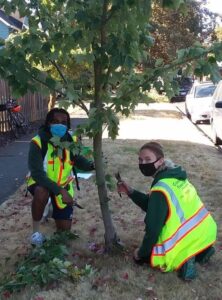
Pruning trees contributes to a more equitable community. Or, more accurately, pruning trees at no cost contributes to a more equitable, livable community.
How? We’ve learned that a major barrier to many households getting a street tree is the cost of maintaining the tree. Pruning can be very expensive, and it gets more expensive as the tree ages and grows if problems are not addressed early. Properly pruning a tree when young is an excellent investment and can delay or even prevent future expenses, making a tree more affordable. Pruning young trees at no cost by trained Friends of Trees volunteers is one important way to help get more trees into more neighborhoods, especially under-served, low-income communities which are often communities of color impacted by systemic disparities. That is exactly why Friends of Trees is focusing efforts on specifically those communities who will benefit the most.
Our pruning program also benefits youth through our educational partnerships. While we are pruning trees we are also training young people to prune. Through partnerships with organizations like Rosemary Anderson HS POIC, student interns in our pruning program earn an hourly stipend while building valuable job skills. Pruning skills can be developed and honed in preparation for becoming an ISA-certified arborist – a very solid living with excellent job security. Added bonus: Exposing young people to the benefits of trees and tree care contributes to a greater appreciation of trees and nature, helping to grow the next generation’s Tree Team.
Pruning = longer lived, healthier trees = healthier planet + people. The benefits of trees—oxygen creation, pollution and stormwater absorption, healthier humans (DYK that trees help combat cardiac and respiratory ailments and can even contribute to increased birthweights?), and so much more—increase exponentially as trees grow and age. And the earlier a tree is properly pruned, the greater the chance it will grow to a ripe old age benefitting neighborhoods and the planet for generations to come.
Pruning for structure (shape) and clearance (sidewalks and streets) is the primary way to steward and care for a tree post-establishment. Proper pruning contributes to the long-term health of the tree, while lack of pruning, or pruning incorrectly, will contribute to the premature demise of the tree. Pruning in the built environment (as opposed to a natural setting) is also key to preventing tree-related damage following inclement weather.
There’s another reason pruning young trees is better: It’s easier for the tree to recover from pruning when it’s young than it is when the tree is more mature (trees have to “recover” after any sort of pruning, good or bad, it’s just far more efficient for them to recover from careful “surgery” by a trained pruner as opposed to “natural” pruning by snow/ice + wind). When pruned, a tree immediately gets to work “sealing” the cut, working to close off the wound.
When pruning young trees, we have the opportunity to make a 5-cent cut today to prevent the need for a $100 cut 20 years down the road (or, so the saying kind of goes ;). Not only is it more cost-effective to properly prune young trees, the larger the pruning cut (because the limbs are larger), the longer it takes the tree to recover. A tree can quickly seal and move beyond a ¼” cut made with hand pruners, but it may takes years to recover from an 8” diameter cut made with a chainsaw (and it may never recover at all). BTW, trees don’t actually “heal,” they seal or compartmentalize and – once recovered – they then grow more vigorously.
With all the benefits of pruning it’s a good thing our pruning program is so popular with volunteers (100+ pruning volunteers every year!), since volunteer-power is the only way we’ll be able to prune 2,000 trees this season. Pruning is especially popular right now as it’s pretty pandemic-resistant: pruning is not a large group activity and it takes place 100% outdoors. In fact, it’s because of COVID that this will be the biggest pruning season yet, with a 40% increase in trees pruned over last season! BTW, we’ll prune any young street tree in our service area (6” diameter or smaller), not just the trees we plant – all at no cost (thanks in large part to our partners at City of Portland Bureau of Environmental Services).
Pruning trees properly contributes to the health of the tree and to those who live under its canopy. We of course want the trees we plant to grow and thrive, and proper pruning when young is key to tree health, so pruning is an important part of our Neighborhood Trees program. Need more information? Visit our tree resources page for more information about tree care and the benefits of trees. Ready for a tree of your own? Get started here!
Photo: Youth interns learning to prune, part of our Rosemary Anderson High School/POIC partnership; August 2020.
Trees for sale – at a great price!
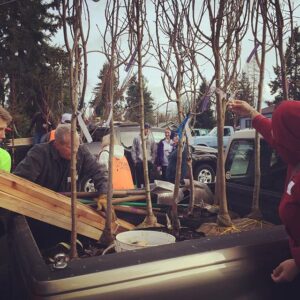
We have some trees for sale – at prices far below retail!
Most of the trees for sale are in containers and are a good size. Conifer trees are at least 5 feet tall; all other trees for sale are 8.5 feet tall with 1.5 inch caliper trunks.
Trees are $75 each, less than wholesale and far less than retail pricing.
Selection is limited and includes a few bigleaf maples, a few types of dogwoods, Persian ironwoods, elms, hornbeams, crabapples, and five different types of oaks. We cannot guarantee this selection so act fast if you’re interested.
Due to social distancing do not come to the office before contacting Gustavo about the purchase process.
Here are the steps to purchase a tree:
- Email Gustavo at [email protected] and put Tree Sale in your subject line.
- Gustavo will let you know what is available, will take your order, and give you payment instructions. Please note: payment must be with a credit card through our website, Gustavo will let you know how to make the purchase.
- Trees will be available for pick up beginning Monday, May 11. We cannot reserve a tree for you until you connect with Gustavo and payment is confirmed.
- Once your payment is confirmed Gustavo will let you know when you can pick up your tree at our office at 3117 NE MLK Blvd, Portland, and what that process will be. Delivery is not available.
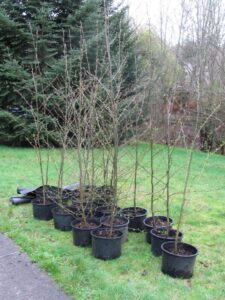 Please direct all questions to Gustavo. And please note that the above and left photos are not of the actual trees for sale, but they are similar in size and will actually have leaves.
Please direct all questions to Gustavo. And please note that the above and left photos are not of the actual trees for sale, but they are similar in size and will actually have leaves.
You can find tree care information here.
Thanks for planting trees and be sure to water your new tree 15 gallons a week through October!
DYK? Trees are also stormwater filters!
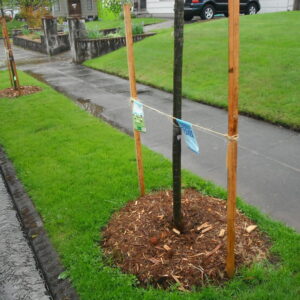
Why all the fuss about managing stormwater? Simply put, stormwater pollutes waterways.
“Stormwater runoff carries dirt, oil and other pollutants to rivers and streams. It can also cause erosion and flooding that harm properties and wildlife habitat.“1
“Portland’s trees are also playing an underappreciated role every time it rains: They’re helping us prevent major flooding and avoid erosion; they are literally holding Multnomah County together.” 4
Traditionally, and still common throughout the country, stormwater is primarily managed through “grey” solutions such as massive construction and excavation projects that install giant pipes to divert the wastewater. Thinking green, Portland conducted a study and found there could be significant savings in the cost of the Big Pipe project by including green infrastructure along with wider sewer pipes.2 Other cities are catching on; Friends of Trees regularly receives inquiries from other cities (a recent call came from Louisville, KY) looking for more information about this partnership and its benefits.
Per an agreement between Portland Parks and Recreation and BES, “Portland’s Bureau of Environmental Services recognizes that, among the numerous environmental, economic, and social benefits trees provide, they can work for clean rivers by helping to manage stormwater where it falls. Planting trees can expand and enhance the urban forest canopy and help the city meet key goals of several plans,” including the City’s Climate Action Plan and Watershed Management Plan.3
In other words, BES recognizes the multiple bottom line trees deliver, and how essential trees are to a healthy, equitable and livable city. For more information about trees and stormwater management (and to check out a very cool interactive model that demonstrates trees’ impact), visit our friends at the Arbor Day Foundation. And when you can safely swim in a river or eat fish from a lake this summer be sure to thank the trees.
Trees: Fighting climate change, growing community AND managing stormwater
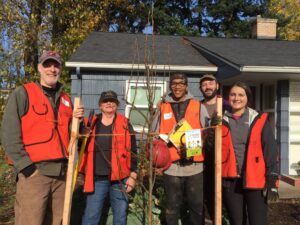
In 2008, Friends of Trees and the City of Portland Bureau of Environmental Services embarked together on a transformative journey to boost green infrastructure in Portland. This initiative built on the Big Pipe project and used green infrastructure to reduce environmental impacts of urban stormwater. Along with creating bioswales, installing green roofs and adding new natural areas, this project mandated the planting of tens of thousands of trees in Portland.
This partnership resulted in 38,000+ street trees planted in Portland from 2008 – 2021, and these street trees intercept 9.6 million gallons of rain each year.1 The trees planted through this partnership represent just a portion of all street and yard trees planted by Friends of Trees since 1989, which is more than 50,000 across the region.
Why all the fuss about stormwater? Learn more here.
This project didn’t just plant small trees and hope for the best. Then-Mayor Sam Adams prioritized planting and caring for large stock trees. Planting larger trees means, of course, that all of the benefits are realized much sooner than if smaller trees were planted.
Caring for the trees is equally important: Friends of Trees’ program includes post-planting support and care, which helps ensure that the trees we plant survive and thrive. Our monitoring program builds on that, telling us how many of the trees we plant survive—and our trees have an excellent survival rate: The survival rate for urban trees planted by Friends of Trees is 97% (based on Portland street trees planted during our last two seasons).
It’s not just stormwater. These trees deliver a triple bottom line, beyond stormwater management:
1. Most of the trees planted through this partnership are planted in historically under-served, low-canopy neighborhoods, bringing the countless benefits of trees to the neighborhoods that need them most.
2. The trees planted are now on the front lines of fighting climate change; each tree we plant will offset 13-48 lbs. of carbon annually.2
3. When planted the Friends of Trees way, with thousands of volunteers, trees grow community. And now more than ever, we need ways to come together as a community, and we need trees.
We’re not done! About 100,000 street tree planting locations remain available in Portland, not to mention throughout our service area that runs from Southwest Washington down to Lane County. We plant a lot of trees every year: Just last season we planted 3,500 street & yard trees and 46,000 seedlings and native shrubs. We know our region and our planet needs more trees and more community-building, and we look forward to enhancing and expanding the wide variety of partnerships we enjoy toward planting a greener and healthier future.
- Data provided by City of Portland Bureau of Environmental Services
- Depending on the age of the tree.
Some of this content is from a video about the project, check it out here.

